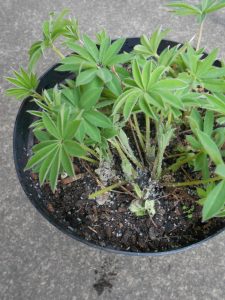We are now observing good growth on the emerging herbaceous plants. Taking a closer look at the emerging foliage on some reveals colonies of bugs and beasties. This image of a Lupin cultivar shows an active colony of Lupin and Macrosiphum albifronsLupin Aphid, Macrosiphum albifrons.
Not easy to control culturally or organically, repeat spraying with dilute dish washing water may reduce the population but never totally wipes it out. Lupin and Macrosiphum albifrons
These aphids overwinter within the shelter of the dead basal foliage, grasping the chance to feed on the fresh sap. These are wingless adults, winged adults appear during the summer when the colony is too large to support itself and these fly away on the breeze to colonise other Lupin plants.



Dagmar Gross
Yes, I have one lupin, “Manhattan Lights”, in a border I have created four years ago in our communal green-space area at the back of my block of flats. I have had it for 3 years now and every spring it is infested with these large green aphids too. As it’s not an edible plant, I spray it with a systemic insecticide and once has been enough so far for the whole season, which I am very happy about.